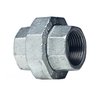If I were to build this clothes rack made from galvanized pipe, how would I tighten the center horizontal bar? The only solution I could come up with is to grind off the threads and put a screw through the coupling into the pipe on each end. The ideal solution would be to reverse thread the pipe on one end, but I don't have any metalworking equipment.



